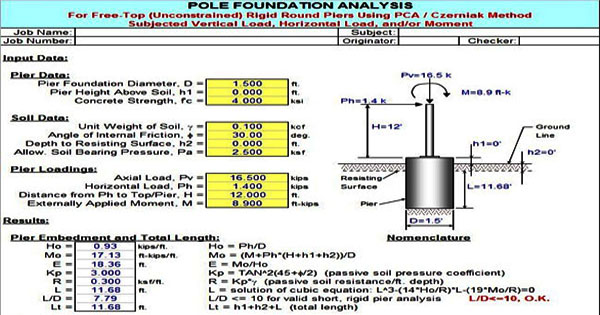POLEFDN – An exclusive construction program for geotechnical engineering

Alex Tomanovich has developed POLEFDN, a powerful program for geotechnical engineering. POLEFDN stands for a MS-Excel based spreadsheet program that is specifically created with the intension of analyzing a pole foundation on the basis of applying a inflexible round pier that is supposed to be free (unrestrained) at the top and likely to withstand lateral and vertical loads. Particularly, the essential embedment depth, the utmost moment and shear, the plain concrete stresses, and the soil bearing pressures are estimated.
This program belongs to a workbook that comprises of six (6) worksheets which are defined as follows:-
- Doc - Documentation sheet
- Pole Fdn (Czerniak) - Pole foundation analysis for free-top round piers using PCA/Czerniak method
- Pole Fdn (UBC-IBC) - Pole foundation analysis for free-top round piers using UBC/IBC method
- Pole Fdn (OAAA) - Pole foundation analysis for free-top round piers using OAAA method
- Granular Soil (Teng) - Pole foundation analysis in granular soil using USS/Teng met
- Cohesive Soil (Teng) - Pole foundation analysis in cohesive soil using USS/Teng method
Program Assumptions and Restrictions:-
1. As there does not exist any method that is globally recognized for pole foundation analysis, this program comes up with five diverse methods of finding embedment length for pole foundations. The "Pole Fdn(Czerniak)" worksheet is considered as the primary method highlighted in this program, because it offers lots of information in entire analysis. On the other hand, it does give in the most conventional embedment depth results among all the existing methods.
2. The references employed in the various analysis methods in this program are given below:
a. "Design of Concrete Foundation Piers" - by Frank Randall Portland Cement Association (PCA) - Skokie, IL, May 1968
b. "Resistance to Overturning of Single, Short Piles" - by Eli Czerniak ASCE Journal of the Structural Division, Vol. 83, No. ST2, Paper 1188, March 1957
c. 1997 Uniform Building Code (UBC), Section 1806.8, page 2-45
d. Outdoor Advertising Association of America (OAAA) - New York, NY
e. "Tapered Steel Poles - Caisson Foundation Design" Prepared for United States Steel Corporation by Teng and Associates, July 1969
f. AASHTO Publication LTS-5 - Standard Specifications for Structural Supports for Highway Signs, Luminaries, and Traffic Signals (Fifth Edition, 2009)
3. The "Pole Fdn(Czerniak)" worksheet imagines that the foundation is short, inflexible and fulfills the ethics that the foundation embedment length divided by the foundation diameter is less than equal to 10.
4. This program deals with both horizontally as well as vertically applied loads. The vertical load may contain a related eccentricity that leads to a supplementary overturning moment to be imagined for being added directly to the overturning moment created with the horizontal load.
5. This program imagines that the top of the pier is at or over the top of the ground surface level.
6. This program guesses that the original resisting surface is situated at or underneath the ground surface level. It is applicable for any weak soil or any soil that should have been eliminated at the top.
7. The "Pole Fdn(Czerniak)" worksheet imagines that the inflexible pier rotates about a point situated at a span, 'a', underneath the resisting surface. The utmost shear in pier is considered to be at that 'a' distance, whereas the maximum moment in the pier is considered to be at a span = 'a/2'.
Download Pole Foundation Analysis Spreadsheet
Article Source
www.cesdb.com

